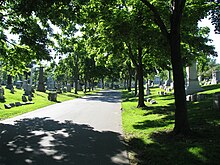Loading AI tools
Historic cemetery in Buffalo, New York From Wikipedia, the free encyclopedia
Forest Lawn Cemetery is a historic rural cemetery in Buffalo, New York, founded in 1849 by Charles E. Clarke. It covers over 269 acres (1.1 km2) and over 152,000 are buried there, including U.S. President Millard Fillmore, First Lady Abigail Fillmore, singer Rick James, Congresswoman Shirley Chisholm, and inventors Lawrence Dale Bell and Willis Carrier. Forest Lawn is on the National Register of Historic Places.
| Forest Lawn Cemetery | |
|---|---|
 | |
 | |
| Details | |
| Established | 1849 |
| Location | 1411 Delaware Avenue, Buffalo, New York 14209 |
| Country | United States |
| Coordinates | 42°55′51″N 78°51′39″W |
| Type | Public |
| Owned by | Forest Lawn Group |
| Size | 269 acres (1.1 km2) |
| No. of graves | 165,000 |
| Website | Forest Lawn.com |
| Find a Grave | Forest Lawn Cemetery |
Forest Lawn Cemetery | |
| Location | 1411 Delaware Avenue, Buffalo, New York 14209 |
| Architect | Clarke, Charles E.; Earnshaw, Joseph |
| NRHP reference No. | 90000688[1] |
| Added to NRHP | May 10, 1990 |
Since its inception, Forest Lawn has served as a cemetery, park, arboretum, crematory and outdoor museum. Monuments, mausoleums and sculptures have attracted visitors for over 150 years. The first sculpture of Seneca Indian chief Red Jacket was erected in 1851. Red Jacket is depicted wearing the richly embroidered scarlet coat presented to him by a British officer, while on his breast is displayed the large silver peace medal awarded to him by President George Washington.[2][3]

Every summer Forest Lawn offers "Sundays in the Cemetery" tours, each with a particular theme. Past examples have included the Pan-American Exposition Trolley Tour, Forest Lawn History Trolley Tour, Forest Lawn History Walk, Civil War Bus Tour and the Forest Lawn Nature Walk.
In 2023, Forest Lawn lobbied the city of Buffalo to block the construction of a four-story mixed-use building with 41 housing units on the site of a former gas station and vacant single-story retail building. Forest Lawn officials argued that the building would have adverse impacts on one of its crematories and cast shadows on the cemetery.[4]
In 2014, the 3,140-square-foot (292 m2)[5] Margaret L. Wendt Archive and Resource Center opened within the cemetery. It is a digitized history center, of interment records maintained since 1849,[5] that features a number of interpretive displays highlighting the notable citizens buried in the cemetery. The building features climate controlled rooms and the design of the building mimics some of the historic structure that once stood at the same site.[6] The staff includes Amizetta Haj (Interpretive Program Director), John Edens and staff. Construction and funding for the Center was provided by The Margaret L. Wendt Foundation along with support from The John R. Oishei Foundation.[5]
In 2004, Frank Lloyd Wright’s 1928 design for the Blue Sky Mausoleum was realized. The Mausoleum contains 24 crypts, which can be purchased and memorialized by individual owners. The Blue Sky Mausoleum is one of three Frank Lloyd Wright memorial sculptures in the world. Sculptor David P. Dowler created a Steuben Glass piece in a limited edition of 26, of which 24 are reserved for those who purchase crypts in the Mausoleum. Crypt clients also receive a copy of architectural historian Richard O. Reisem's 2005 book, Blue Sky Mausoleum of Frank Lloyd Wright.
Other mausoleums in the cemetery include:
Seamless Wikipedia browsing. On steroids.
Every time you click a link to Wikipedia, Wiktionary or Wikiquote in your browser's search results, it will show the modern Wikiwand interface.
Wikiwand extension is a five stars, simple, with minimum permission required to keep your browsing private, safe and transparent.